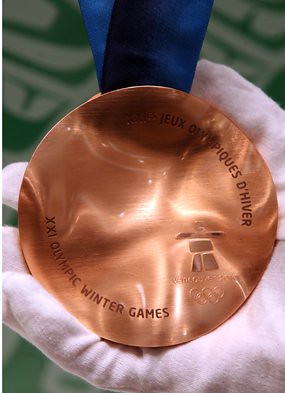
PREV ARTICLE
NEXT ARTICLE
FULL ISSUE
PREV FULL ISSUE
MAKING THE 2010 OLYMPIC MEDALS AT THE ROYAL CANADIAN MINT
Yes, those 2010 Olympic medals are WAVY. This fabulous article from the Ottawa Citizen describes the problems encountered by the Royal Canadian Mint in making them.
-Editor
"Their true journey starts now," says Renato Romozzi, the mint's design coordinator. "When these medals find their rightful owners, they are going to represent Canada all over the world. We're so proud. They're such beautiful medals." The mint assembled 34 engineers, engravers, die technicians, machinists and production experts to make the 615 Olympic and 399 Paralympic medals. It was probably the most challenging job ever faced by the mint, says Romozzi, 53. "I don't think we've made anything that comes close to the complexity," he says. "We've never put together a group of people like we did for this medal; a lot of people, a lot of technologies." It was the final step of a two-year creative process that spanned the country. Viewed from the side, the medal forms a gentle wave shape, inspired by the ocean, mountains and snow drifts of British Columbia. "They will be unique," says Jim Greensfelder, a Florida collector who wrote a reference guide to Olympic medals. "There's never been a medal that's had that (wavy) contour," he says. "People will recognize it as being very distinctive for Vancouver and Canada." No two medals are alike. Each of the 1,104 medals is engraved with a different segment cropped from two drawings by Hunt. She chose to depict a killer whale or orca on the Olympic medals "because of its strength and beauty and athleticism, as well as the idea that the orca travels within its community," she says. "All the medals together make the complete art work," says Arbel. "Every athlete's story is unique, but together they're part of a larger Olympic whole." Weighing between 500 and 576 grams, the medals are among the heaviest in Games history. "Athletes like them heavier," says Greensfelder. "They feel like it's more substantial, that it's worth more." The Olympic medals are circular, 100 mm in diameter. The Paralympic medals are a squared-circle and measure 95mm by 95mm. For the first time, Paralympic medals are equal in size to Olympic medals. "Paralympic are usually much smaller," says Romozzi. "These set the standard now for the rest of the world to follow. "The challenge for us was to strike a medal with bumps," says Romozzi. "This is not something that is very common in our industry. Coins are flat. Some have high relief, but nothing like this." They experimented with press settings and designs of dies, metal blocks imprinted with undulations which give the medals their shape. Many early attempts were melted down. "Our guys did the most incredible thing," says Romozzi. "They did something the (machine's manufacturer) didn't know you could do. They trained the laser to know what the rings were. They would jump over, laser inside and jump out." On the reverse side, the medals contain the official names of the Games in English and French, Vancouver 2010's emblems, and the name of the sport and event the medal was awarded in. Finally, each medal is clad in transparent protective coating to prevent wear and tarnishing. After 402 days, the medals were finished. The $2 million feat was part of the mint's sponsorship of the Games. "They shipped out Jan. 8, so we lost them," says Romozzi. "It was a sad moment. We got so attached to them." In the search for a medal that would reflect Canada and delight athletes, the design team learned "just how much meaning a small object could have," says Arbel.
To read the complete article, see:
Minting the medals on Sussex Drive
(www.ottawacitizen.com/sports/Minting+medals+Sussex+Drive/2562800/story.html)
The Numismatic Bibliomania Society is a non-profit organization promoting numismatic literature. See our web site at coinbooks.org. To submit items for publication in The E-Sylum, write to the Editor at this address: whomren@gmail.com To subscribe go to: https://my.binhost.com/lists/listinfo/esylum All Rights Reserved. NBS Home Page Contact the NBS webmaster 
|
